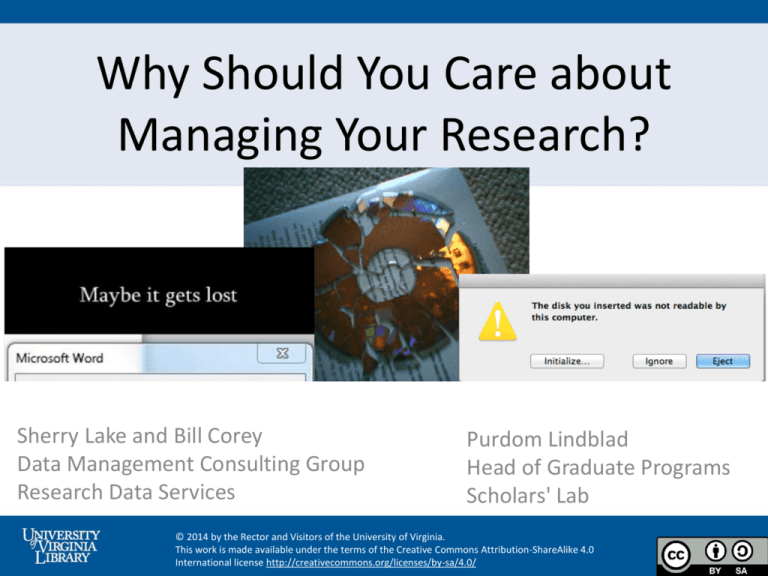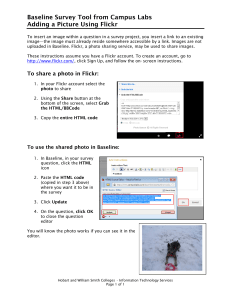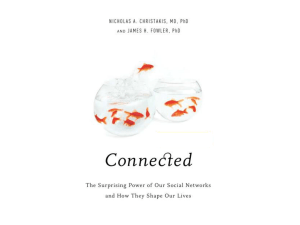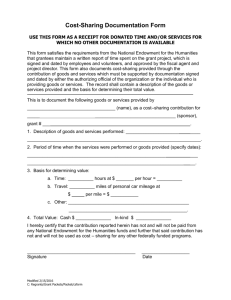Why Should You Care about Managing Your Research?
advertisement

Why Should You Care about Managing Your Research? Sherry Lake and Bill Corey Data Management Consulting Group Research Data Services Purdom Lindblad Head of Graduate Programs Scholars' Lab © 2014 by the Rector and Visitors of the University of Virginia. This work is made available under the terms of the Creative Commons Attribution-ShareAlike 4.0 International license http://creativecommons.org/licenses/by-sa/4.0/ Roadmap • Goals of the Workshop • Why are you here? • What’s your research materials? • Review & Discuss data management case study • What is Data Management and why should you care? https://www.facebook.com/charlottesvillevirginia Photo Instagrammer ihugtrees05 Workshop Goals • Identify potential data management problems Personal Collection: Sherry Lake • Learn what is meant by “Data Management” • Why do you need to know about Data Management • Generate interest to come to Part 2 next week (and bring friends) Introductions In groups 1. Introduce yourself 2. Talk about what research materials you have 3. What do you want to get out of this workshop? Report back on 2 & 3 Case Study Discussion • Watch “Recovering Eyebeam’s Archive” video. http://vimeo.com/53849333 • Generate list of types of materials that you work w/ and the risks associated with them (Individual) • Groups – generate best practices for protecting those materials and/or the content • Report back How Research is Done From Flickr by diylibrarian www blog.order2disorder.com From Flickr by csessums From Flickr by csessums Data Metadata Sources Recreated from Klump et al. 2006 Borrowed from Carly Strasser How Research Should be Done From Flickr by diylibrarian www Data Metadata Sources www From Flickr by torkildr Recreated from Klump et al. 2006 Borrowed from Carly Strasser Who Cares about Data Sharing? From Flickr by Redden-McAllister www.rba.gov.au From Flickr by AJC1 What do we mean by … Managing your research… • Ensuring physical integrity of files and helping to preserve them • Ensuring safety of content (data protection, ethics, morality, etc.) • Describing the data (via metadata) and recording its history (provenance) • Providing or enabling appropriate access at the right time, or restricting access, as appropriate • Transferring custody at some point, and possibly destroying (Good) Data Management… …helps research to be: Replicated and verified Preserved for future use Linked with other research products Shared and reused …helps researchers: Meet funding requirements Increase visibility of research Save time and effort (avoid data loss) Deal with an ever-increasing amount of data http://www.healthcare-informatics.com/article/guest-blog-data-management-challengeunlocking-value-clinical-data-many-times-requires-enter The Foundation Reuse Data Sharing Data Management From Flickr by Michael Tinkler Who’s Requiring Data Management? Require a Data Management Plan (DMP) Require Sharing of Results – per a Data Policy • National Endowment of Humanities – Office of Digital Humanities (NEH) • National Endowment for the Arts (NEA) • National Science Foundation • Institute of Museum and Library Services (IMLS) • National Institutes of Health • National Oceanographic and Atmospheric Research (NOAA) • • • • This list is not inclusive. Andrew W. Mellon NASA NEH – Preservation & Access IES – Institute of Education Sciences • Wellcome Trust Parts of a Data Management Plan I. Roles & Responsibilities: responsibilities regarding the management of your data will be delegated; including time allocations, project management of technical aspects, training requirements, and contributions of non-project staff--individuals should be named where possible. II. Expected Data: The types of data, samples, physical collections, software, curriculum materials, and other materials to be produced in the course of the project. III. Period of Data Retention: Explain the policies that may restrict the distribution of your data, and describe how you will make sure that access to data is made available in a timely manner. IV. Data Formats and dissemination: Explain of the format of your data and how that format will allow for fast and easy access to the data V. Data Storage & Preservation of Access: Describe your longterm strategy for storing, archiving and preserving the data from the research described in the proposal. 13 National Endowment for the Humanities Office of Digital Humanities • Data Management Plan requirements aligned with NSF. • Data Management Plan requirements and guidance based on the NSF-SBE: Social, Behavioral, and Economic Sciences Directorate. Digital Curation Guide A community resource guide to data curation in the digital humanities http://guide.dhcuration.org/ Managing Data in the Data Life Cycle • Choosing file formats • File organization & naming conventions • Version control • Access control & security Data Discovery Proposal Planning Writing Project Start Up • • • • Backup & storage File format conversions Document all data details Sharing and preservation Re-Use Data Collection Data Analysis Deposit Data Archive Data Sharing Re-Purpose Data Life Cycle End of Project Questions? Sherry Lake Bill Corey Purdom Lindblad shLake@virginia.edu wtc2h@virginia.edu jpl8e@virginia.edu http://dmconsult.library.virginia.edu http://scholarslab.org Case Study Lessons Kara Van Malssen, an expert who stepped up to help rescue the Eyebeam archives, and her colleagues performed triage, created a recovery plan, and lead the volunteer team that stabilized the collection. In April 2013 she published a case study on the recovery of the media: Recovering the Collection, Establishing the Archive http://www.avpreserve.com/wp-content/uploads/2013/05/RecoveringTheEyebeamCollection.pdf 4 Preparedness Takeways • Storage: avoid storing media in basements, near windows, directly under a roof, in direct sunlight, in leak-prone areas. Cool & dry is best. • Intellectual Control: maintain an item-level inventory. Printed and digital copies. • Deaccessioning: keep what you need. “Getting rid of items can be a challenge. Spending time after a disaster, cleaning things that don’t need to be, is an even bigger one” • Labeling: multi-part media such as video, audio and data tape should have labels on all parts.







